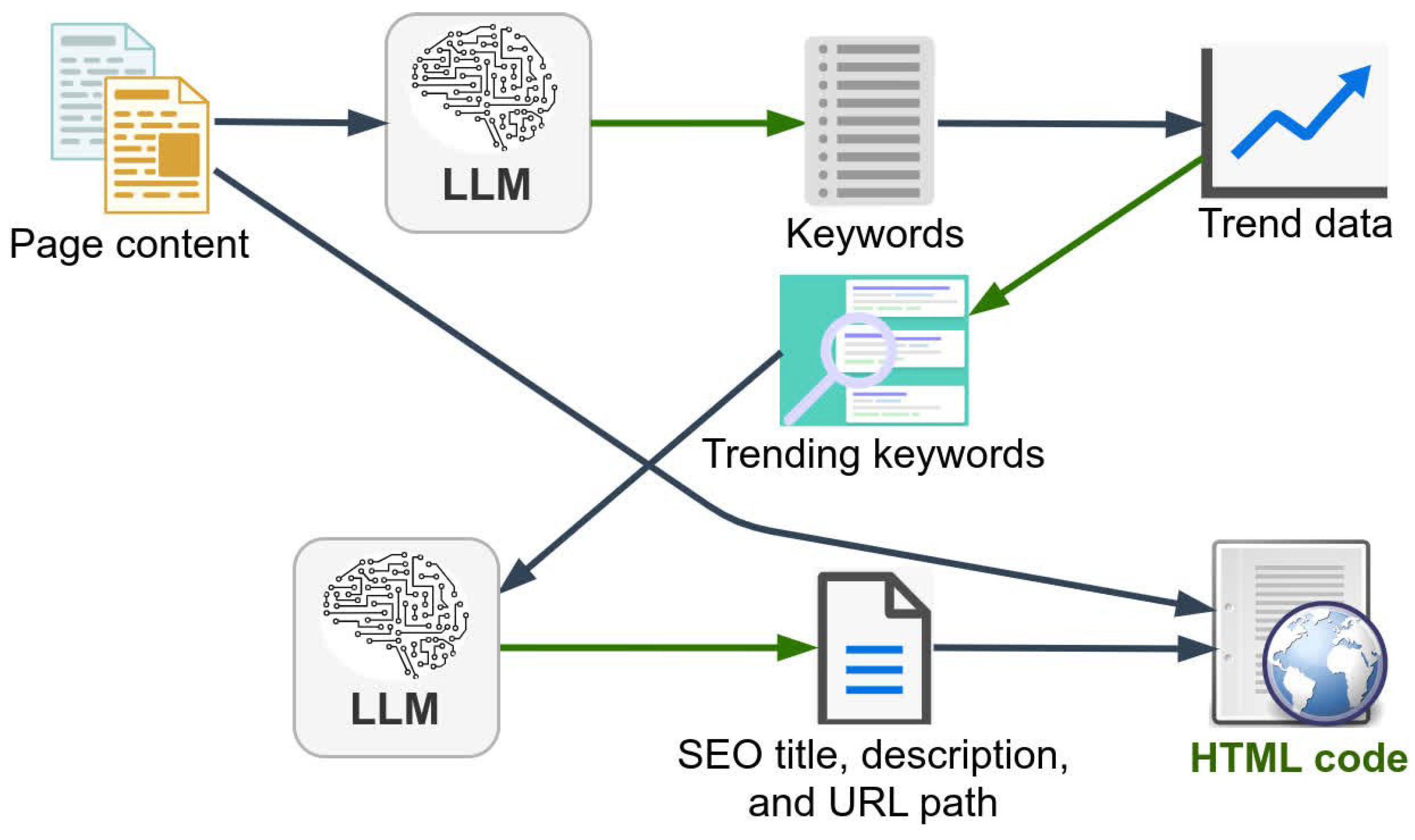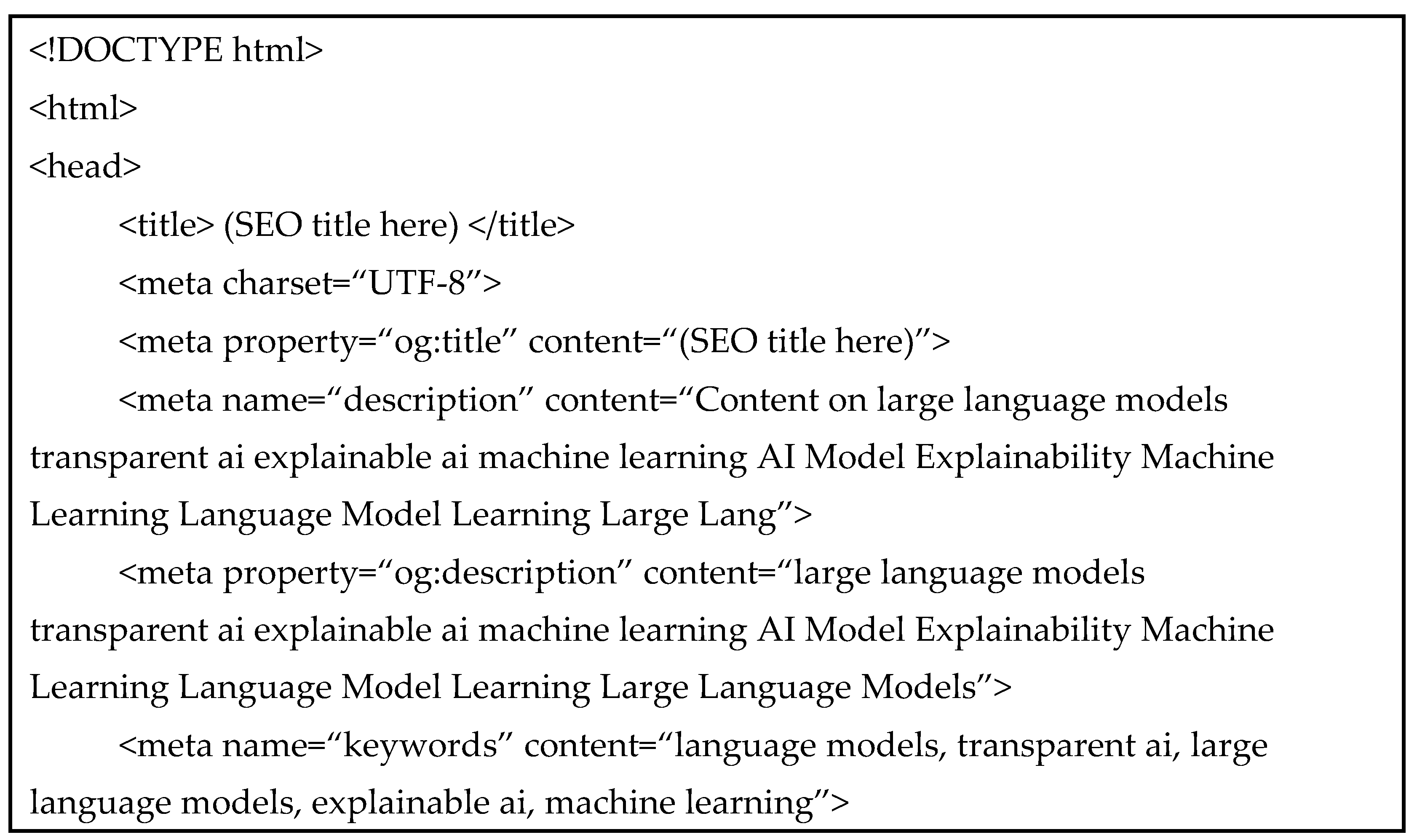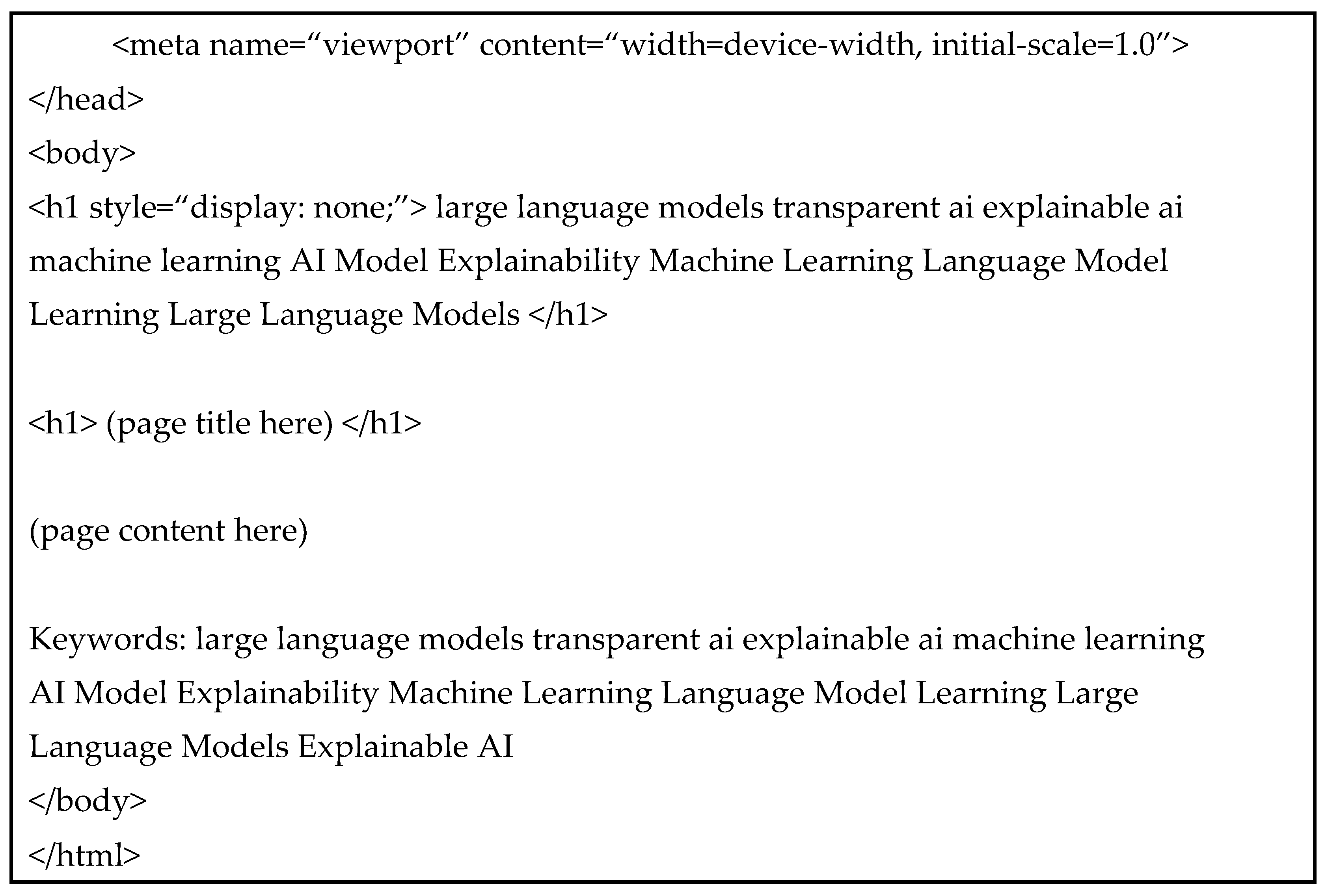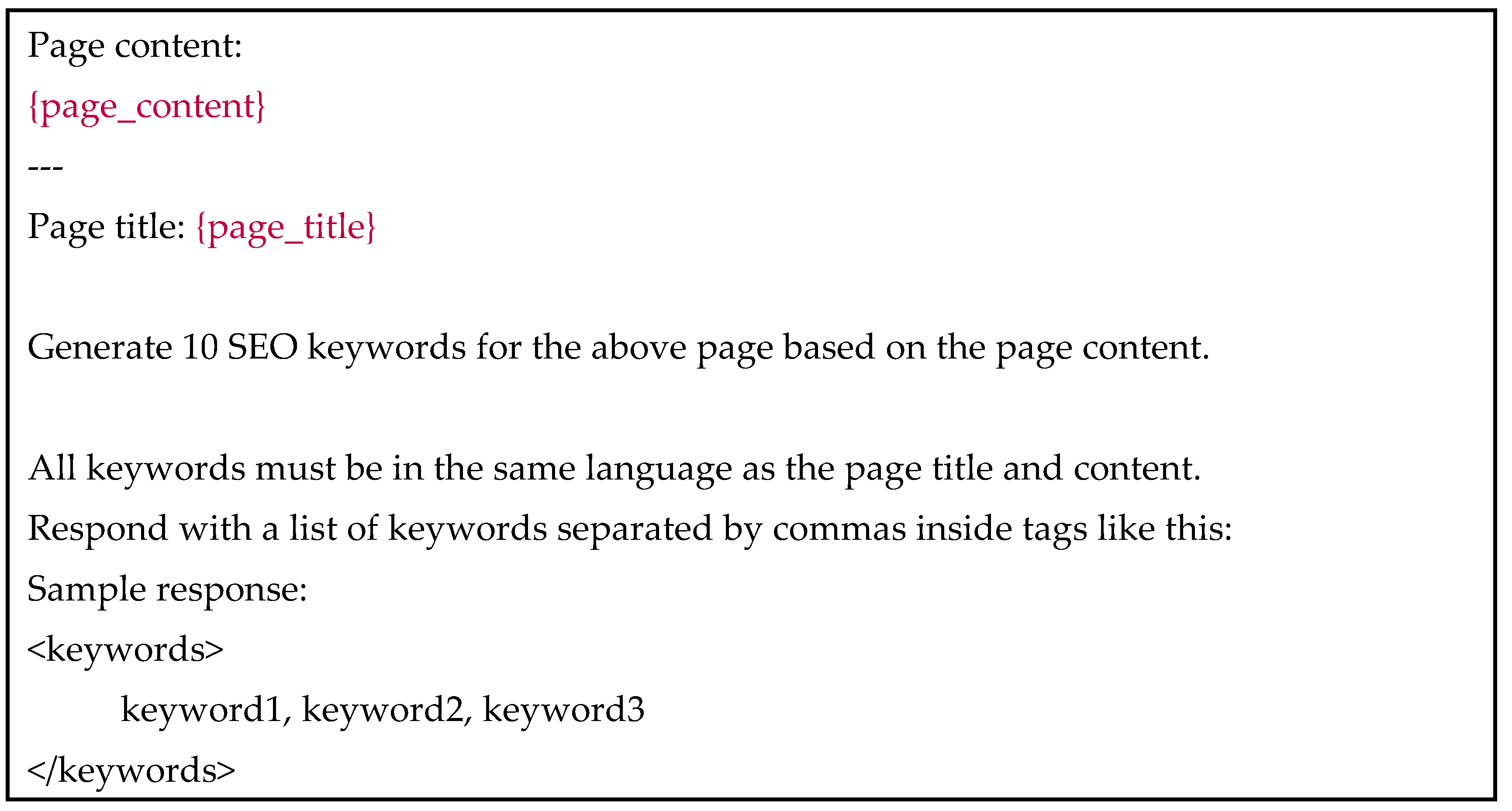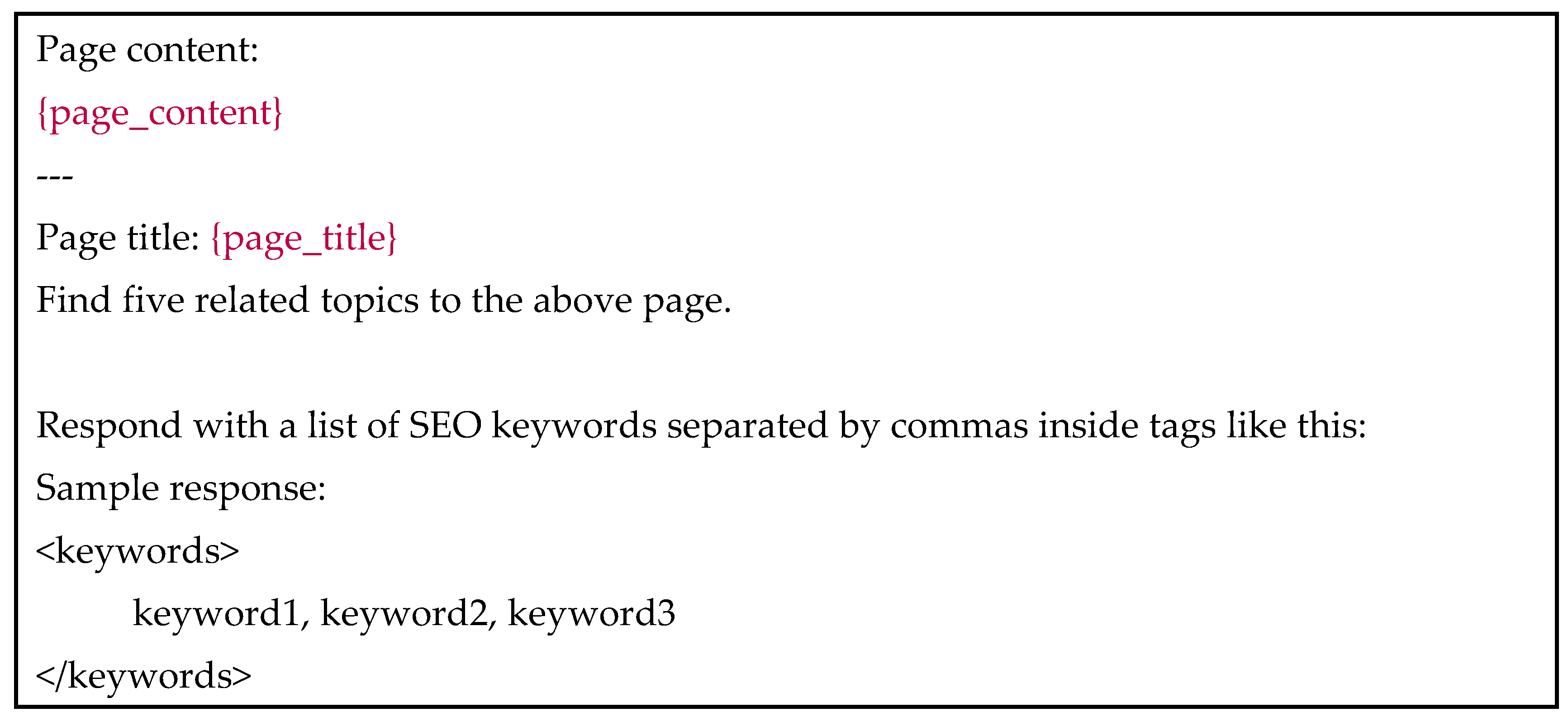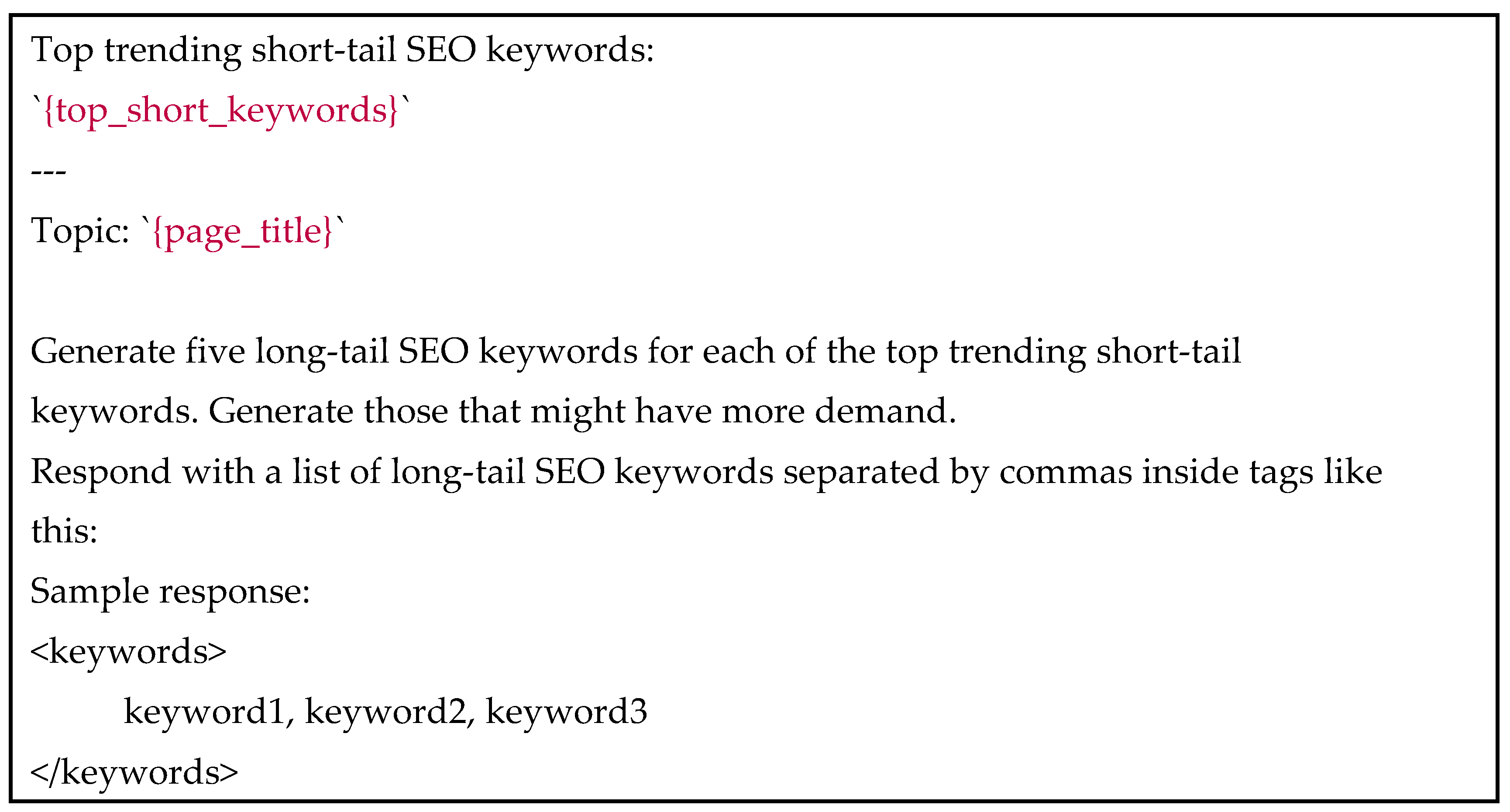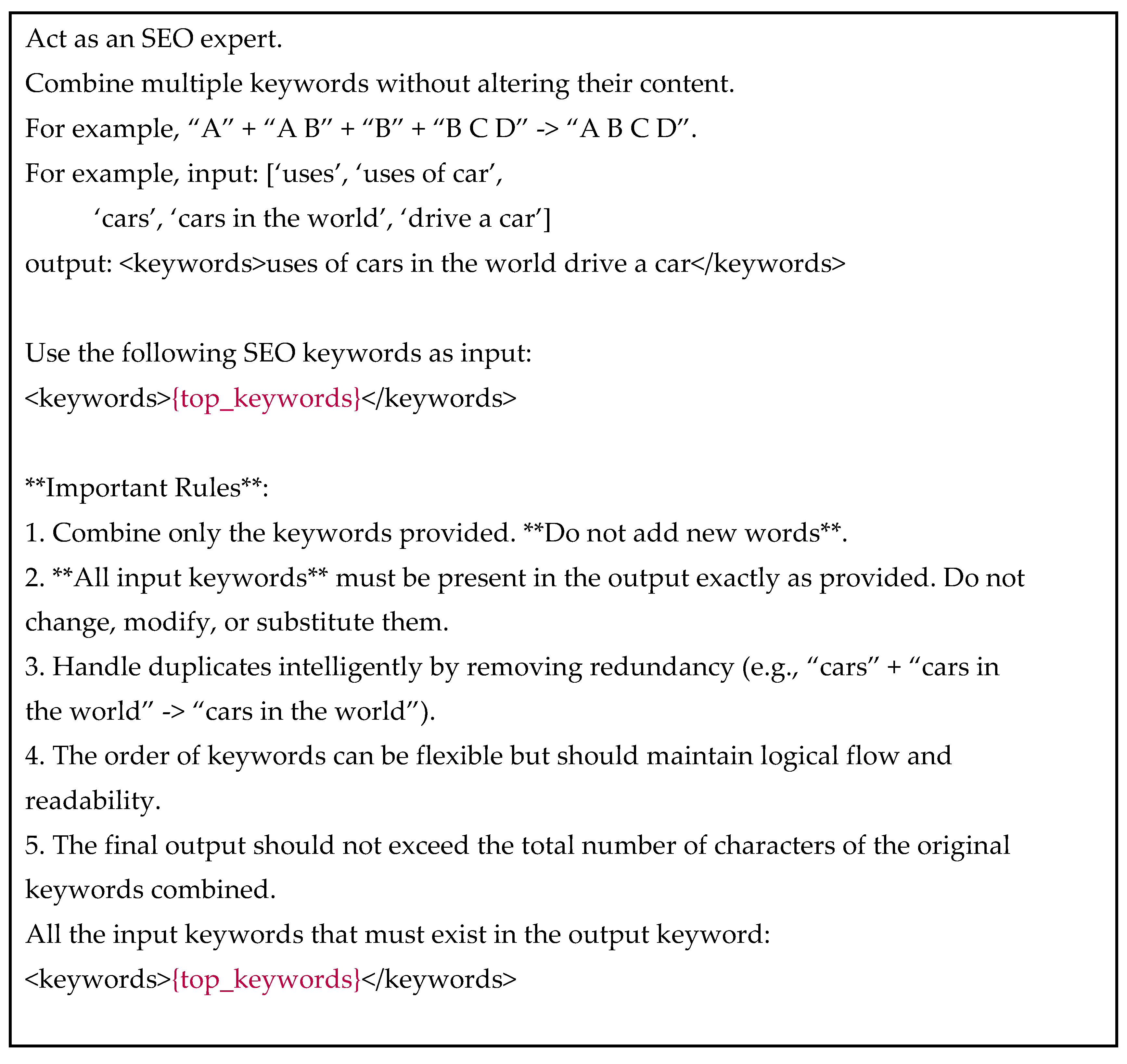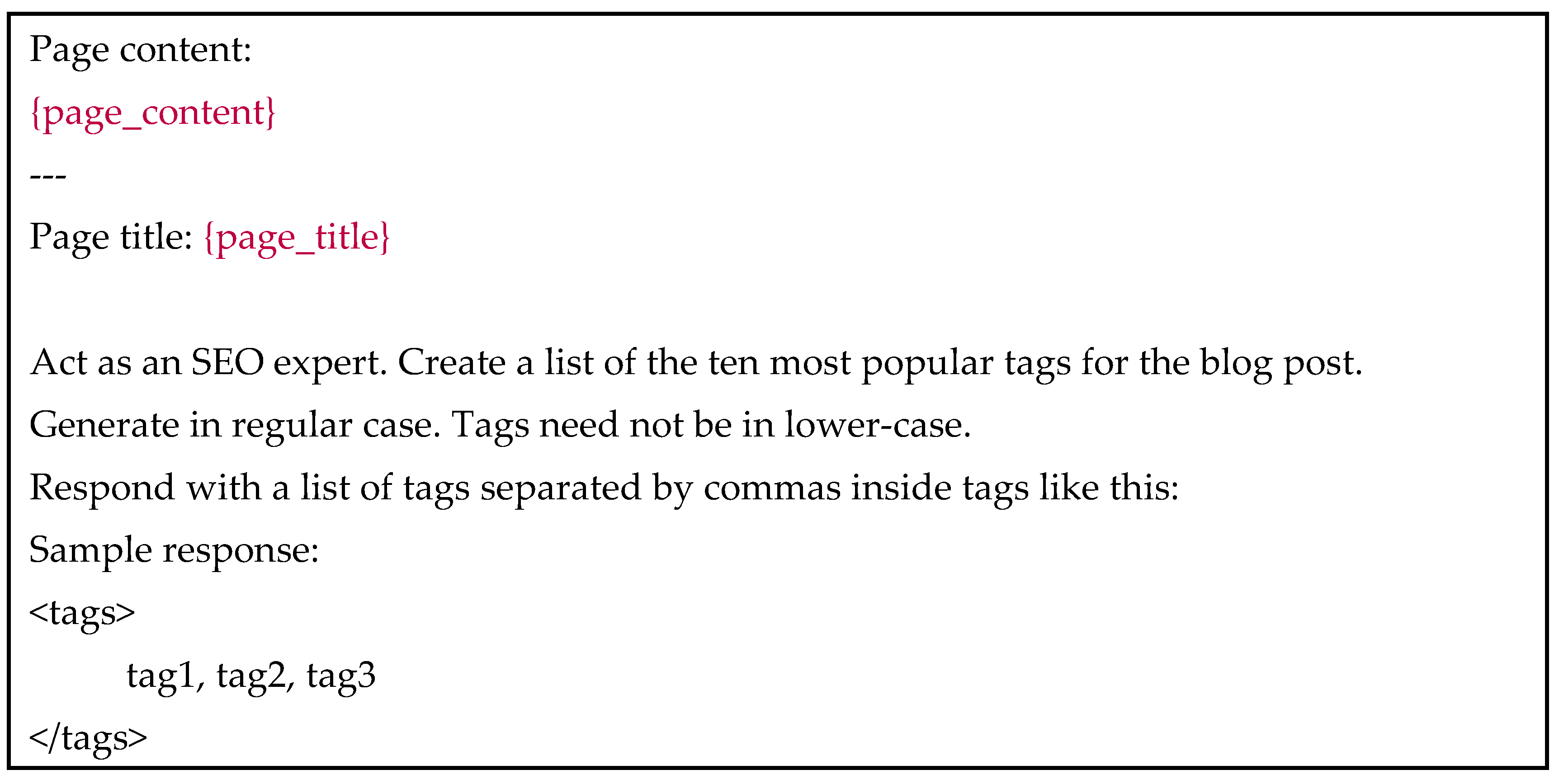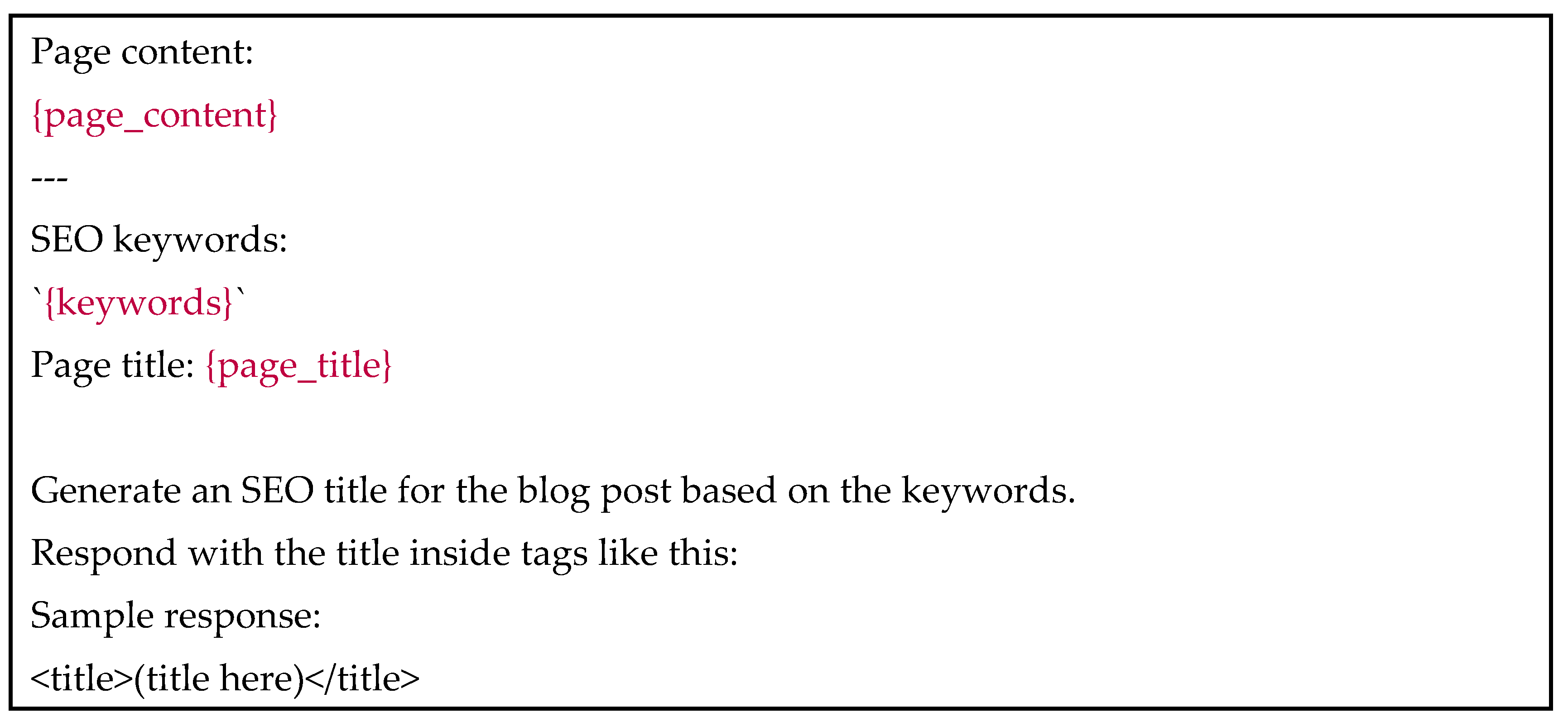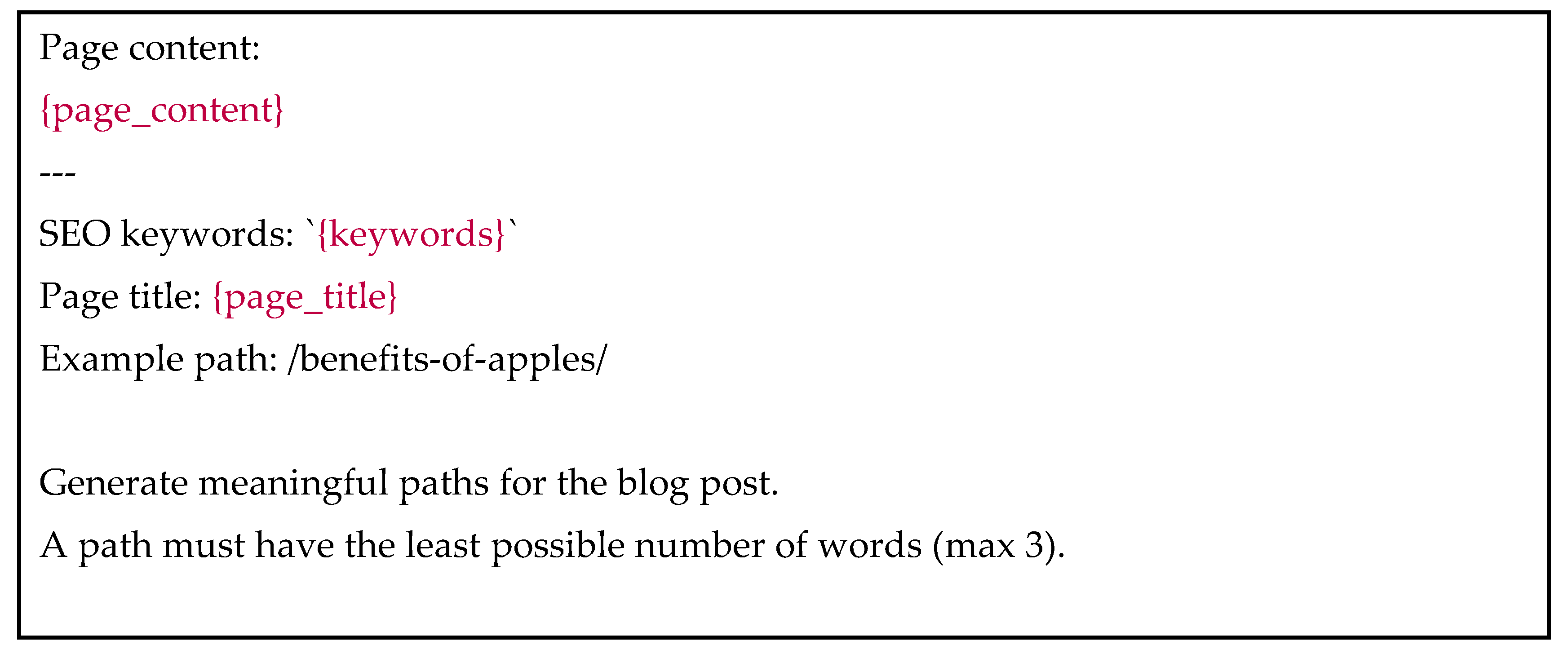1. Introduction
Search engine optimization (SEO) is important to ensure that online content reaches the intended audience who expect to find the desired content for a web page [
1]. Keywords are essential in SEO to connect user queries to relevant content across the web, improving content discovery [
1]. Numerous keywords can be derived from a web page.
1.1. Limitations of Current Fixed-Keyword Approaches
Traditional SEO practices involve the manual selection of keywords and embedding in the content at the time of writing page content [
1]. Content creators select the keywords before content creation, commonly based on topics of the content, trends, and historical data. The popularity and relevance of each query shift over time based on user interests [
2], often resulting in the keywords becoming outdated. As a result, maintaining the visibility and relevance of a web page remains a challenge without continuous manual adjustments.
1.2. Disadvantages of Manual-Only Approaches
Considering a high number of pages to maintain, reliance on manual SEO practices introduces challenges related to scalability, timeliness, cost, and effectiveness. The practices require dedicated SEO teams [
3]. Manual processes can introduce challenges for smaller businesses and non-profit organizations that lack the resources to obtain and maintain dedicated SEO teams. Additionally, reliance on manual approaches fails to persist with trends during non-working days, when SEO teams are unavailable to react to shifts in user behavior. Such reliance can result in missed opportunities for traffic during critical moments, such as viral trends of a query related to a web page the organization owns. Furthermore, manually chosen keywords might reflect human biases.
1.3. Proposed System and Its Benefits
SEO keywords can be generated using LLMs and embedded into the HTML code of a page [
4,
5,
6]. AutoTrendyKeywords is proposed as a system that continuously generates keywords using large language models (LLMs) and shortlists the most trending keywords, sustaining the effectiveness of keywords in SEO. The system uses unsupervised usage of LLMs, which allows it to autonomously generate and update SEO keywords without requiring manual input or predefined datasets for training. This continuous process ensures that the system can adapt in real-time to changing trends. The system is transparent as it displays the trend data before selecting the keywords and selects keywords based on a fixed procedure. This transparency enhances trust in the system and enables further improvements. Page content changes rapidly for the majority of web pages [
7]. The system provides significant advantages for such dynamic content by continuously updating keywords, thereby ensuring new traffic from relevant audiences. Short and readable URL paths that include keywords are helpful for users in a decision to open a page, as well as for search engines to know what the page is about [
8]. Hence, the process involves generating a new relevant path using the LLM based on trending keywords when creating a web page. Constantly adding new paths that redirect to the page might lead to a consequence of retaining too many paths.
1.4. Societal Impact of the System
AutoTrendyKeywords benefits organizations and also has a broader positive impact on users and society. It allows a broader number of users to find the desired content using the desired query. The system can generate keywords in the native language of the content, ensuring a presence within search engine results for queries in that language. Such presence broadens access to information in unpopular languages, thus promoting inclusivity and linguistic diversity.
2. Related Work
Chodak et al. [
4] explored the integration of LLMs into SEO activities for online retailers, in addition to content creation and keyword generation. Automating the generation of HTML code and content optimization for search engines is a notable advancement in using LLMs for SEO. However, a research gap exists on how keywords can be automatically changed based on changes in trends. Ziakis et al. [
9] have emphasized the efficiency gained through AI for automating SEO tasks such as keyword research, content creation, backlink analysis, and technical aspects of SEO. However, existing literature predominantly addresses the short-term benefits of AI automation, with limited exploration of its efficacy in adapting to long-term fluctuations in search trends. LLMs have gained considerable attention in SEO processes, particularly in e-commerce. Previous research has highlighted several advancements in using LLMs in SEO for content generation and product visibility. However, there are significant research gaps regarding maintaining reasonable visibility. The gaps allow further exploration into the development of unique AI applications for SEO to preserve visibility in search results in the long run.
3. Methods
3.1. Selecting an LLM and Trend Data Source and Loading Page Content
The first step involves selecting an appropriate LLM that will be capable of generating keywords based on the topic of the web page and its content. Llama 3.1 (70B) [
10,
11] is selected due to its proven capabilities in natural language generation and handling text. Trend data is sourced from Google Trends [
12]. The language selected is English. The page content is written for a blog article and saved in a file. The LLM, trend data source and page content are loaded into the system for the experiment.
3.2. Generating Keywords
The LLM is used to generate two sets of keywords. The first set of 10 keywords is generated using the LLM based on the page title and content. The keywords are ensured to be directly related to the content, ensuring these keywords are closely aligned with the core message of the content. These keywords are directly associated with the page’s theme and are considered essential SEO keywords. Another set of 5 keywords generated are broader terms related to the title of the content. For example, if the content is about the benefits of apples, the first set of keywords includes keywords such as “apples and health” and “health benefits of apples,” while the second set includes “benefits of eating fruits” and “healthy snacks for digestive health.” The keywords from both sets are combined, and any duplicates are removed. The keywords are converted to lower-case to maintain uniformity with search queries since most queries in search engines are in lower-case. The keywords generated in this step are short-tail keywords and have up to 4 words.
3.3. Fetching Trend Data
Trend data is fetched for each generated keyword for a defined time period of one week. The attributes used from the data are the demand for the keyword at the start and the end of the time period. The trend is calculated as the percentage of change in the demand of the query from the start to the end. The keywords with zero current demand are eliminated and not considered for the next steps, ensuring only active keywords are retained for further utilization. The remaining keywords are then sorted primarily using the growth, based on the assumption that future demand might be the same or higher than the current demand for the most trending queries. If the growth is the same for two queries, they are sorted based on the current demand. This process ensures that only the keywords with a high future potential are prioritized and considered for the next steps. The time period selected is not more than one week since the system can be used to change keywords once a week.
3.4. Generating Long-Tail Keywords from Most Trending Keywords and Fetching Their Trend Data
Users frequently use more specific queries called long-tail keywords when querying a search engine. Hence, long-tail keywords are necessary for a wide reach of the page. Long-tail keywords are generated in this step using the LLM based on the top 10 most popular short-tail keywords. The trend data of the long-tail keywords is fetched and processed using a method similar to processing short-tail keywords in the previous step. Each long-tail keyword generated in this step typically contains up to 7 words.
3.5. Generating a Description for Metadata
A meta description is crucial for SEO as it helps search engines find the summary of the page, which helps find the relevance of the page for a query. A value for metadata description is generated for SEO using the LLM based on the top 5 most demanded keywords from both sets of keywords. The value is ensured to contain all the selected keywords using an auto-retry mechanism. The value is also ensured to exclude any words that are not in the selected keywords. It is crucial to include all the trending keywords in the meta description.
3.6. Generating Tags Based on Keywords, Page Title, and Content
Tags play an essential role in organizing and categorizing the content for both search engines and users. Tags are supported by multiple blogging platforms. Tags play a vital role if the page is published on such platforms, as tags attract more potential readers to the page. The LLM is used to generate a set of 10 initial tags based on the page content. Trend data for each tag is fetched and evaluated using a method similar to fetching trend data for keywords. The top 5 most trending tags are retained, as most blogging sites allow only five tags for each article.
3.7. Generating a Title for SEO
A title is generated for SEO using the LLM based on the page content, keywords, and the page title. A distinct title for SEO facilitates the SEO process without altering the page title decided by the author. The SEO title allows better visibility of the page across the search engine results.
3.8. Usage of the Keywords in the Tags of the HTML Page
All the tags are added to the description value to ensure a broader coverage in search engines. HTML code is created for the article. The generated keywords and the description are included in the HTML code using metadata tags to ensure the effectiveness of the utilization of the generated keywords. The first 155 characters of the SEO description are considered as per the limitations of search engines. There is a possibility of adding keywords in HTML hidden heading tags at the start of the page to allow better visibility across search engines.
3.9. Generating Relevant Paths
URL paths are also critical for SEO, as they contribute to the overall visibility and navigability of the website. Two paths are generated using the LLM based on the page title, content, and keywords. The second path generated would be helpful if the first path is already used. Since the paths are keyword-rich, the search engines can detect the keywords in the URL path, and the users searching using a trending query can easily find the page. Hence, paths make the content more reachable to the intended audience.
Figure 1.
Workflow of AutoTrendyKeywords.
Figure 1.
Workflow of AutoTrendyKeywords.
4. Results
4.1. Generated Keywords
The blog was written based on a research paper on AI. The LLM generated 15 unique keywords after processing the page title and content. The keywords generated are “machine learning,” “language models,” “explainable predictions,” “data-augmented prediction,” “transparent ai,” “interpretable machine learning models,” “lml-dap,” “large language models,” “dataset analysis,” “data prediction methods,” “explainable ai,” “natural language processing applications,” “transparent machine learning,” “interpretable predictive models,” and “data-driven decision making.”
These keywords reflect the core focus of the blog and include terms related to cutting-edge trends in machine learning and AI research. The keywords span a variety of important themes. Additionally, these terms align with emerging interests in AI. This keyword selection contains both general concepts and specialized topics within the field of AI, thus broadening the potential audience base.
4.2. Keywords Sorted and Filtered Based on Trends
After generating the initial set of keywords, trend data was successfully fetched to assess their popularity and relevance. The results shown in
Table 1 below reveal key insights into the trend data. The term “explainable ai” exhibited the highest growth, with a dramatic increase from 1 to 89, representing an 8800% surge in popularity. The results acknowledge that the content of the blog aligns with trending topics. By focusing on keywords with a demonstrated growth in demand, the SEO strategy is likely to improve the blog’s visibility in search results, capitalizing on these upward trends.
4.3. Generated Long-Tail Keywords and Their Trend Data
To create more specific search queries, the system generated five long-tail keywords based on the trending short-tail keywords. The keywords generated are “Language models for data prediction,” “Language models for machine learning applications,” “Training language models on small datasets,” “Language models for data augmentation techniques,” and “Using language models for predictive analytics.”
The trend data for the generated long-tail keywords is shown in
Table 2 below. Trends revealed that none of them had current demand, with each showing a negative growth trend. The lack of current demand suggests that the keywords relevant earlier are no longer relevant. Hence, they were filtered out before further consideration. The shifts imply that these keywords would have been beneficial if the system had been run in the past, and the keywords trending at a time might eventually lose the trend over time. The changes in the trend emphasize the importance of using the system to continuously monitor trends and adapt to shifting trends.
4.4. Generated Metadata Description
To create a concise, SEO-optimized meta description, five of the most trending keywords were considered step. The keywords considered are “language models,” “transparent ai,” “large language models,” “explainable ai,” and “machine learning.” The description is successfully generated by combining all the keywords and contains all the keywords. The description generated is “large language models transparent ai explainable ai machine learning.” By focusing on keywords with high demand, the meta description is successfully optimized to increase the likelihood of the page appearing in relevant search results.
4.5. Generated Tags
The ten tags generated by the LLM are “Transparent AI,” “Explainable AI,” “Machine Learning,” “Large Language Models,” “Natural Language Processing,” “AI for Healthcare,” “Data Augmented Prediction,” “Interpretable AI,” “Artificial Intelligence,” and “Language Model Learning.” The top 5 most demanded tags are considered for the next steps. The trend data of all the generated tags are mentioned below. The top 5 most trending tags are selected for the next steps, which are “AI Model Explainability,” “Machine Learning,” “Language Model Learning,” “Large Language Models,” and “Explainable AI.” The keywords mentioned earlier are in lower-case, and the trend data is different for the same word in lower-case. Tags require the words in regular casing instead of lower-case, and the trend data of tags is different from that of keywords.
Table 3.
Tags sorted and filtered based on trends.
Table 3.
Tags sorted and filtered based on trends.
| Keyword |
Oldest_Value |
Latest_Value |
Growth |
| AI Model Explainability |
1 |
100 |
9900 |
| Machine Learning |
51 |
72 |
41 |
| Language Model Learning |
46 |
65 |
41 |
| Large Language Models |
44 |
58 |
32 |
| Explainable AI |
40 |
50 |
25 |
| AI Predictions |
42 |
48 |
14 |
| Transparent AI |
57 |
64 |
12 |
4.6. Sample HTML File after Embedding the Values
The generated keywords, SEO title, description, and keywords were incorporated into the HTML structure of the page to optimize its SEO performance. The HTML code includes trending keywords in relevant tags to ensure effective SEO utilization.
Figure 2.
Sample HTML code of the page, excluding the title and content.
Figure 2.
Sample HTML code of the page, excluding the title and content.
4.7. Generated Relevant URL Paths
The paths generated by the LLM are “/explainable-ai-predictions” and “/lml-dap-alternative-ml.” The paths are short and successfully include keywords that are relevant to both users and search engines.
5. Discussion
AutoTrendyKeywords has proven the potential to change conventional practices by implementing a real-time automated system that adapts to emerging trends by updating the keywords based on trends. The focus on sustaining web page relevance and discoverability for users in the long term remained the core focus and strength of the system. Using keywords generated by the system allows us to mitigate human bias and create a more inclusive and fair online ecosystem. The system remains further useful if the page content changes on a regular basis. The system can be modified to generate keywords for content in endangered languages to preserve the visibility of the content by allowing visibility of the content in the languages. The growing affordability of the usage of LLMs ensures that the system is affordable for individual creators and non-profit organizations.
The method does not include analysis of competitors to manipulate rankings to over-rank competitors for profit, as it remains only academic. The aim is to keep a web page discoverable to relevant audiences who intend to find the content and not to subdue the online marketplace for financial gain. AutoTrendyKeywords is not designed for profit-maximizing strategies or LLM-based content optimization, unlike existing SEO tools on the market. The experiment uses only one source of trend data, and more sources of real-time trend data could be used.
6. Conclusion
AutoTrendyKeywords offers a solution to the challenges of SEO by successfully using the power of LLMs to continuously generate keywords and select the trending keywords based on real-time trends to update the keywords. In the experiment, the system generated 15 relevant keywords, with some showing a highly growing trend over the selected time period of one week. The system demonstrated a successful generation and selection of keywords, along with the generation of the title and description of the page for SEO. The system generated URL paths that are short and contain the trending keywords. Filtering keywords based on trend data resulted in the selection of the most impactful terms to maintain SEO performance.
The approach is set to become essential for SEO professionals and organizations to maintain the relevance of a web page for the long term, stimulating a future where page content continues to remain accessible. As LLMs continue to become more affordable and faster, the system can be run frequently. The system can be tested for videos since keywords can be generated based on descriptions and subtitles. With future research, the system can be modified to predict future trends based on the historical data of scheduled regular events and festivals to change keywords on a schedule. The system can be modified to generate the keywords for the images using multimodal LLMs to enhance sustained visibility across the results of image searches.
Author Contributions
The author is the sole contributor to this research
Funding
This research received no external funding.
Data Availability Statement
The source code used for the experiment is available at github.com/Pro-GenAI/Auto-Trendy-Keywords.
Conflicts of Interest
The authors declare no conflicts of interest.
Appendix A
Figure A1.
Prompt template to generate keywords based on the page content.
Figure A1.
Prompt template to generate keywords based on the page content.
Figure A2.
Prompt template to generate keywords related to the topic of the page.
Figure A2.
Prompt template to generate keywords related to the topic of the page.
Figure A3.
Prompt template to generate long-tail keywords based on trending short-tail keywords.
Figure A3.
Prompt template to generate long-tail keywords based on trending short-tail keywords.
Figure A4.
Prompt template to generate metadata description for SEO.
Figure A4.
Prompt template to generate metadata description for SEO.
Figure A5.
Prompt template to generate tags.
Figure A5.
Prompt template to generate tags.
Figure A6.
Prompt template to generate a title for SEO.
Figure A6.
Prompt template to generate a title for SEO.
Figure A7.
Prompt template to generate paths.
Figure A7.
Prompt template to generate paths.
References
- M. Nagpal and J. A. Petersen, Keyword Selection Strategies in Search Engine Optimization: How Relevant is Relevance?, J. Retailing 2021, 97. [CrossRef]
- S.-P. Jun, H. S. Yoo, and S. Choi, Ten years of research change using Google Trends: From the perspective of big data utilizations and applications, Technological Forecasting and Social Change 2018, 130. [CrossRef]
- Here’s When – and How – You Should Hire an SEO Expert for Your Business, Entrepreneur. Available online: https://www.entrepreneur.com/growing-a-business/hiring-an-seo-expert-will-transform-your-business-heres-7/435990 (accessed on 12 Oct. 2024).
- G. Chodak and K. Błazyczek, Large Language Models for Search Engine Optimization in E-commerce. In Proceedings of the Advanced Computing Conference, Cham, Switzerland, Mar. 2024: Springer Nature. [CrossRef]
- G. Matošević, J. Dobša, and D. Mladenić, Using Machine Learning for Web Page Classification in Search Engine Optimization, Future Internet 2021, 13. [CrossRef]
- R. Maragheh et al., LLM-TAKE: Theme-Aware Keyword Extraction Using Large Language Models. In Proceedings of the 2023 IEEE International Conference on Big Data (BigData), Los Alamitos, CA, USA, 15-18 December 2023: IEEE Computer Society. [CrossRef]
- V. Mallawaarachchi, L. Meegahapola, R. Madhushanka, E. Heshan, D. Meedeniya, and S. Jayarathna, Change Detection and Notification of Web Pages: A Survey, ACM Comput. Surv. 2020, 53. [CrossRef]
- SEO Friendly URLs. Available online: https://backlinko.com/hub/seo/urls (accessed on 12 Oct. 2024).
- C. Ziakis and M. Vlachopoulou, Artificial Intelligence’s Revolutionary Role in Search Engine Optimization, In Proceedings of the The International Conference on Strategic Innovative Marketing and Tourism, Cham, Switzerland, Jun. 2024: Springer Nature. [CrossRef]
- Llama 3.1 [Language model]. Available online: https://github.com/meta-llama/llama3/blob/main/MODEL_CARD.md (accessed on 12 Oct. 2024).
- Dubey et al., The Llama 3 Herd of Models, 2024, arXiv:2407.21783. Available online: https://arxiv.org/abs/2407.21783 (accessed on 12 Oct. 2024).
- Google Trends [Data source]. Available online: https://trends.google.com/trends/explore?date=now%207-d (accessed on 12 Oct. 2024).
|
Disclaimer/Publisher’s Note: The statements, opinions and data contained in all publications are solely those of the individual author(s) and contributor(s) and not of MDPI and/or the editor(s). MDPI and/or the editor(s) disclaim responsibility for any injury to people or property resulting from any ideas, methods, instructions or products referred to in the content. |
© 2024 by the authors. Licensee MDPI, Basel, Switzerland. This article is an open access article distributed under the terms and conditions of the Creative Commons Attribution (CC BY) license (http://creativecommons.org/licenses/by/4.0/).

